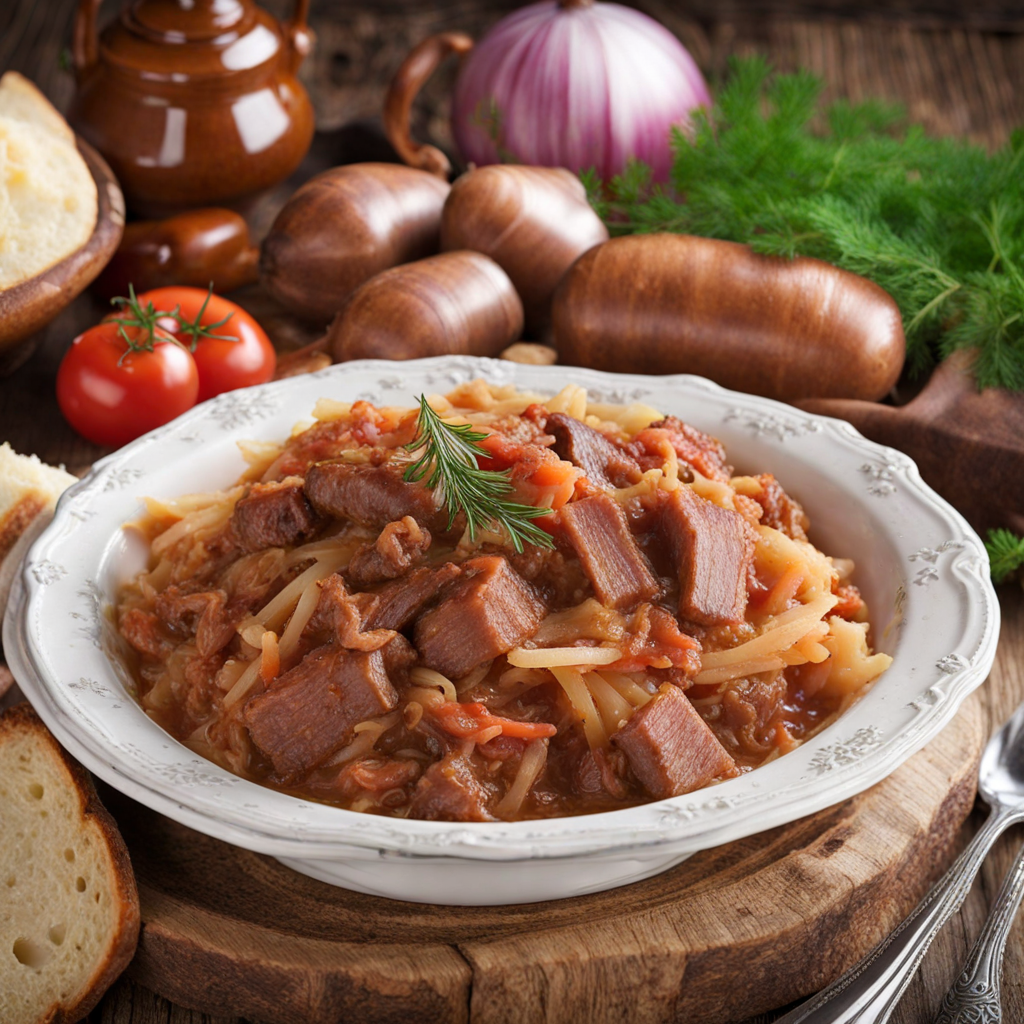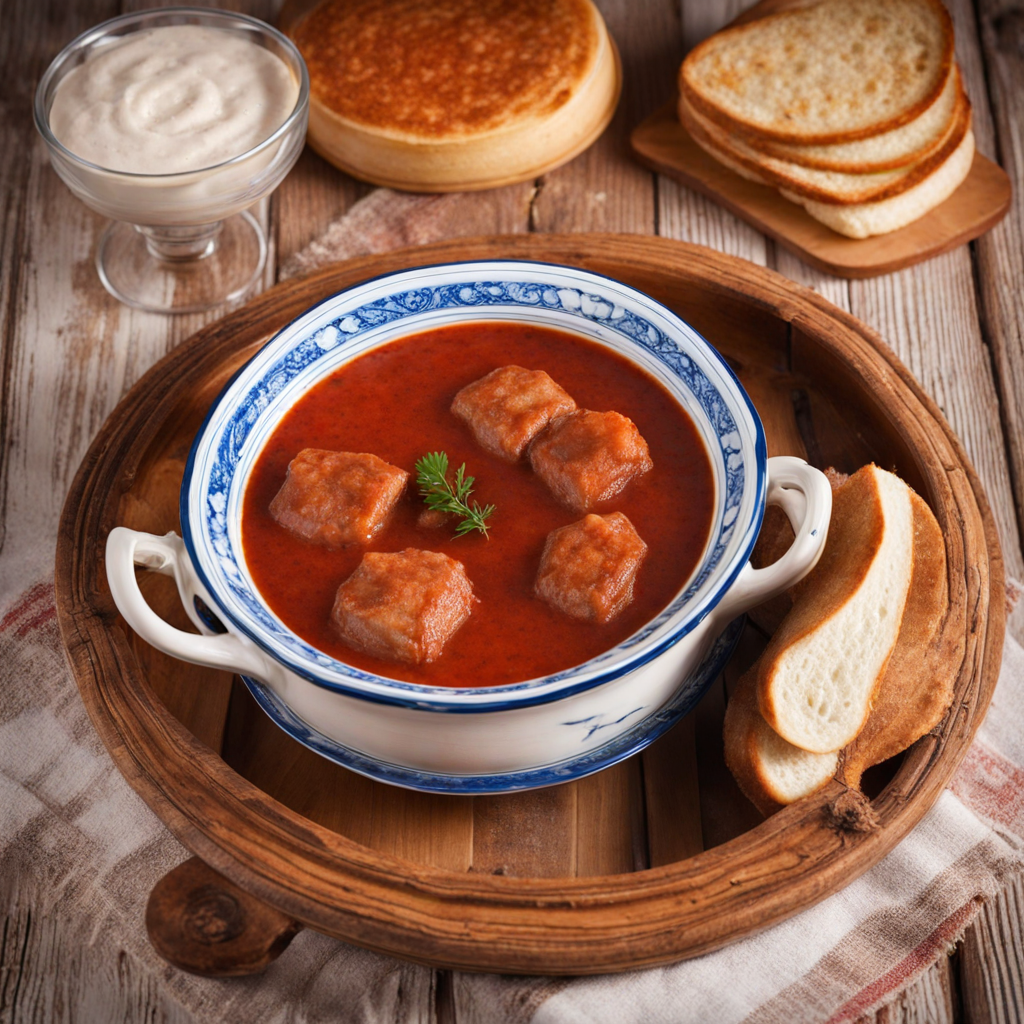Bigos
Bigos, often referred to as "hunter's stew," is a traditional dish that beautifully encapsulates the heart of Belarusian cuisine. This flavorful concoction typically features a rich base of sauerkraut and fresh cabbage, which provide a delightful tanginess and depth. The dish is further enhanced by a medley of meats, commonly including pork, beef, and sometimes sausage, which are slow-cooked to tender perfection. The combination of these ingredients creates a hearty and satisfying meal that warms the soul, perfect for the colder months when it is most commonly enjoyed. In addition to meats and cabbage, Bigos is seasoned with a variety of spices and herbs that elevate its taste profile. Ingredients like bay leaves, allspice, and black pepper add complexity, while the inclusion of mushrooms and onions introduces earthy undertones. The slow-cooking process allows the flavors to meld beautifully, resulting in a dish that is both comforting and robust. Each family may have its own variation, making Bigos a dish steeped in tradition and personal touch, often passed down through generations. Serving Bigos is a delightful experience that invites sharing and gathering around the table. It is typically accompanied by a side of hearty bread, perfect for soaking up the savory juices. Some may choose to add a dollop of sour cream or a sprinkle of fresh herbs for an extra layer of flavor. The dish not only nourishes the body but also brings people together, making it a beloved staple in Belarusian households and a must-try for anyone looking to discover the rich culinary landscape of Belarus.
How It Became This Dish
The History of Бігас: A Culinary Gem of Belarus #### Origins Бігас, pronounced "bigas," is a traditional dish from Belarus that reflects the rich tapestry of the country's agricultural heritage and culinary practices. Its origins can be traced back to the rural communities of Belarus, where hearty, filling meals were vital for sustaining the labor force engaged in agriculture and other physical tasks. The dish primarily consists of a base of fermented, fermented rye or wheat dough, which is often enriched with a variety of ingredients, including meats, vegetables, and spices, all of which can vary by region and family tradition. The name "бігас" is believed to have derived from the word "big," which means "to cook" or "to boil" in the Belarusian language, indicating the method of preparation. Historically, the dish was a staple during the long, harsh winters, providing warmth and sustenance to families. The use of fermented dough not only enhanced the flavor but also allowed for the preservation of the dish, making it an essential part of the peasant diet. #### Cultural Significance In Belarusian culture, food serves as a cornerstone of socialization and festivity. Бігас holds a special place in the hearts of Belarusians, often associated with family gatherings and communal feasts. It embodies the spirit of sharing, as the dish is typically prepared in large quantities, allowing it to be served to numerous guests. It is a common feature at weddings, harvest festivals, and holiday celebrations, emphasizing its role in community bonding. Moreover, Бігас is intricately linked to agricultural cycles. Traditionally, it was prepared during the harvest season as a way to celebrate the bounty of the land. Ingredients such as potatoes, cabbage, and various meats reflect the staples grown in Belarus, showcasing a deep connection to local agriculture. The dish is also a testament to the resilience of Belarusian culture, with its ability to adapt and flourish despite historical adversities, including wars and political upheaval. #### Development Over Time As Belarusian society evolved over the centuries, so too did the recipe and preparation methods of Бігас. Initially, the dish was cooked over an open fire, with a heavy iron pot suspended above the flames. This method not only imparted a distinct smoky flavor but also allowed for slow cooking, which was essential for tenderizing tougher cuts of meat. With the advent of modern cooking appliances, preparation methods began to shift, with many households now opting for electric stoves and slow cookers, yet the essence of Бігас remains unchanged. The industrialization of Belarus in the 20th century brought about significant changes in food production and consumption patterns. As urbanization increased, traditional farming practices began to decline, leading to a reliance on processed foods. However, the resurgence of interest in traditional and local cuisines in the late 20th and early 21st centuries has seen a revival of Бігас in both homes and restaurants. Chefs and home cooks alike have sought to preserve the authentic flavors of the dish while incorporating contemporary culinary techniques and innovative ingredients. In recent years, there has been a growing movement towards sustainable and organic farming in Belarus, which has further influenced the way Бігас is prepared. Many cooks now prioritize locally sourced ingredients, emphasizing the importance of supporting local farmers and reducing the carbon footprint associated with food production. This shift has not only enhanced the quality of the dish but has also reinforced its connection to the land and its people. #### Regional Variations As with many traditional dishes, Бігас boasts a variety of regional interpretations that highlight the diverse culinary landscape of Belarus. In some regions, the dish may include mushrooms foraged from the nearby forests, while in others, it might feature smoked meats that provide a depth of flavor. The use of spices can also vary; certain areas prefer the warmth of black pepper and garlic, while others might opt for the sweetness of caraway seeds or dill. In the Grodno region, for example, Бігас may be prepared with a mix of cabbage and potatoes, reflecting the local agricultural practices. Meanwhile, in the Minsk region, you might find a version that incorporates beans or lentils, attesting to the dish's adaptability and the influence of neighboring culinary traditions. #### Modern Interpretations Today, Бігас continues to evolve, as chefs experiment with modern techniques and global flavors. Contemporary interpretations might include the use of quinoa or farro in place of traditional grains, catering to the growing demand for healthier, gluten-free options. Some restaurants are even reimagining Бігас as a fine dining experience, plating it with artistic flair and pairing it with artisanal breads and local craft beers. Despite these modern twists, the fundamental principles of Бігас remain intact. It is still viewed as a dish that brings people together, serving as a reminder of Belarus's agricultural roots and the importance of community. Whether enjoyed in a cozy family kitchen or a bustling restaurant, Бігас continues to be a symbol of Belarusian identity and resilience. #### Conclusion The journey of Бігас from its humble rural origins to its contemporary status as a beloved dish exemplifies the dynamic nature of culinary traditions. It is a testament to Belarus's rich agricultural heritage, cultural significance, and the ability of food to connect people across generations. As interest in traditional cuisines continues to grow, Бігас not only serves as a delicious meal but also as a bridge to the past, linking modern Belarusians with their ancestors and the land they cherish. In a world increasingly dominated by fast food and transient culinary trends, Бігас stands as a comforting reminder of the value of heritage, community, and the simple joy of sharing a meal.
You may like
Discover local flavors from Belarus







